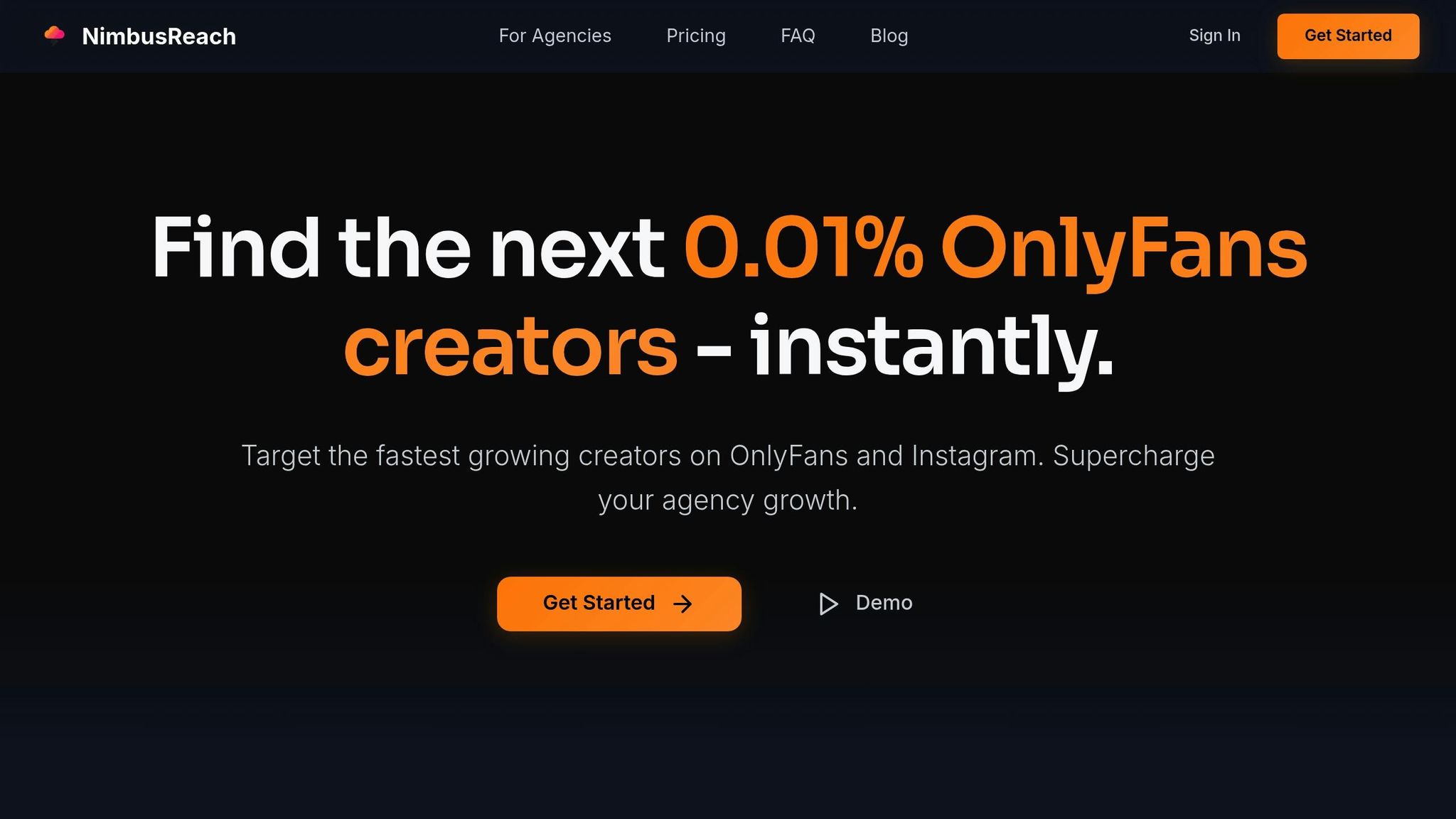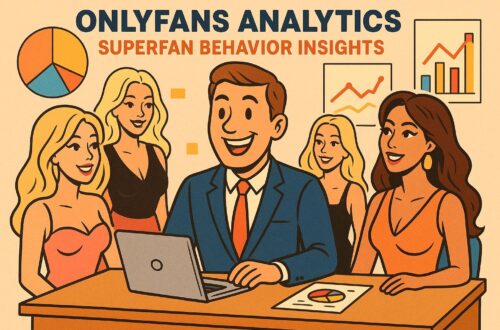Fake followers are a growing problem in the creator economy, affecting platforms like OnlyFans and Instagram. These accounts – whether bots, inactive profiles, or purchased followers – inflate numbers but offer no real engagement. The result? Misleading metrics, wasted marketing budgets, and damaged trust between creators, agencies, and brands.
Here’s what you need to know:
- Fake followers include bots, abandoned accounts, and profiles bought in bulk. They don’t interact meaningfully with content.
- Red flags include low engagement despite high follower counts, sudden spikes in followers, and audience data that doesn’t match the creator’s niche.
- Impact: Campaigns underperform, engagement rates drop, and credibility suffers. This affects both creators’ earnings and agencies’ relationships with clients.
- Tools to help: Platforms like NimbusReach, Social Blade, and Modash analyze follower authenticity and engagement trends.
- Action steps: Regularly audit followers, remove suspicious accounts, and monitor growth patterns to maintain a genuine audience.
Fake followers don’t just distort numbers – they harm trust and business outcomes. By focusing on real engagement and transparency, creators and agencies can safeguard their reputation and marketing investments.
What Fake Followers Are and How They Damage Your Business
Fake Followers Explained
Fake followers are fake accounts created to inflate follower counts. These could be automated bots, abandoned profiles, or accounts from click farms. Unlike real followers who genuinely care about the content, these accounts offer no real value.
Bot accounts are easy to spot. They usually have usernames like "user12345678" or random jumbles of letters and numbers. Their profiles are often filled with stock images, blank bios, or nonsensical text. While they might drop generic comments like "nice post", they don’t engage in any meaningful way.
Inactive accounts are profiles that were once active but have been abandoned. Even though they’re technically real, they don’t contribute to engagement.
Purchased followers are typically created by click farms, where workers manage hundreds of fake accounts. These accounts might show slight activity, but they have no genuine interest in the content.
The main difference is clear: real followers are actual people who engage with content because they care, while fake followers are just there to make numbers look good. This not only inflates audience size artificially but also damages engagement and trust.
How Fake Followers Damage Creators and Agencies
Fake followers don’t just look bad – they can have a serious impact on creators and agencies. For creators on platforms like OnlyFans, where income depends on real engagement, fake followers create a false sense of reach. This gap between inflated numbers and actual audience size can hurt credibility.
Agencies working with creators who have a lot of fake followers face their own set of problems. Marketing campaigns underperform because the expected audience doesn’t exist. Engagement rates plummet, conversions fall short, and budgets are wasted. In the U.S., where businesses rely heavily on data-driven decisions and clear reporting, this kind of failure can damage professional relationships and strain budgets.
Fake followers also mess up engagement metrics. Since these accounts don’t interact with content, even successful creators can seem less engaging than they are. This can push creators toward buying even more fake followers to hide low engagement, creating a vicious cycle that erodes authenticity.
For agencies, fake followers are a financial risk. Campaigns based on inflated follower counts rarely deliver results, making it hard to justify the money spent. This can lead to poor partner choices, dissatisfied clients, and strained business relationships.
At the end of the day, trust is everything. In a world that values transparency and honesty, fake followers can ruin reputations – for both creators and the agencies representing them.
How Do You Vet Influencers For Fake Followers? – Modern Marketing Moves
Warning Signs That Point to Fake Followers
Spotting fake followers often comes down to closely analyzing engagement, growth trends, and audience data. Here are the key red flags that can help you identify inauthentic followers.
Poor Engagement Numbers
A major giveaway of fake followers is a mismatch between the number of followers and the level of interaction on posts. Genuine followers typically engage with meaningful comments or authentic interactions. On the other hand, fake accounts often leave generic or automated responses, if they interact at all. If a creator has thousands of followers but only a handful of likes, comments, or shares, it’s worth taking a closer look.
Strange Follower Growth Patterns
Real follower growth usually happens gradually or spikes in response to viral moments or major collaborations. In contrast, sudden, unexplained jumps in follower numbers often suggest fake followers were purchased. A quick scan of follower profiles can also provide clues – accounts with random usernames, generic profile pictures, or incomplete bios are often bots.
Audience Data That Doesn’t Add Up
Audience demographics can reveal a lot about authenticity. A genuine audience should align with the creator’s content and target market. For instance, someone sharing retirement advice shouldn’t have a predominantly teenage audience.
Geographic data is another strong indicator. As CreatorIQ explains:
"Perhaps the easiest way to identify fraud is when a creator’s audience over-indexes in bot farm hotbeds like Bangladesh, Brazil, and India."
If a U.S.-based creator targeting American audiences has an unusually large following from regions known for click farms – or from areas unrelated to their content – it’s a red flag.
To dig deeper, ask for first-party analytics. Request screenshots of audience insights, including demographics, top locations, and gender breakdowns, and ensure the data aligns with the creator’s niche.
This issue isn’t small. Back in 2019, about $255 million out of the $1.4 billion spent on Instagram influencer marketing in the U.S. and Canada went to fake influencers. Verifying audiences is essential to safeguard marketing budgets and ensure campaigns hit the right targets.
sbb-itb-bd3d2dc
Tools and Methods for Checking Followers
Once you’ve identified potential warning signs, the next step is to use specialized tools to verify the authenticity of an audience. By combining analytics platforms with careful manual evaluation, you can separate genuine followers from fake or inactive accounts.
Using NimbusReach for Advanced Analytics

NimbusReach offers powerful analytics to help assess audience quality. Its features include the Fan Devotion Score, growth alerts, and a detailed dashboard that provides a clear view of follower authenticity. The Starter plan costs $25 per month and includes 250 profile views with advanced filtering options. For those who need more, the Growth plan at $50 per month allows up to 1,000 profile views and includes bulk export tools for deeper analysis.
Other Tools for Follower Analysis
- Social Blade: This free tool is great for tracking follower growth trends across different platforms. It allows you to review historical data, helping you spot gradual growth versus sudden spikes, which could indicate inorganic activity.
- Modash: Modash specializes in influencer analytics, offering detailed reports on audience quality. It breaks down follower demographics and engagement rates, making it easier to spot questionable accounts.
- Instagram Creator Studio: As a first-party tool, Creator Studio provides reliable data like audience demographics, top locations, and peak activity times. This can be especially useful when cross-referencing follower authenticity with other tools.
By combining these tools with a hands-on approach, you can build a robust strategy for cleaning up and managing your followers.
Step-by-Step Guide to Clean Up Your Followers
- Monitor growth and engagement regularly: Conduct monthly audits to identify unusual patterns before they become major issues.
- Remove suspicious accounts: Look for followers with incomplete profiles, random usernames, or no posts. Blocking these accounts helps maintain an accurate follower count.
- Set up alerts: Use tools to notify you of sudden spikes in followers or drops in engagement.
- Document changes: Take before-and-after screenshots of key metrics for reporting purposes.
- Establish baseline metrics: After cleanup, record engagement rates, average likes, and comment quality to create a reliable benchmark for future growth.
These steps, combined with the right tools, can help you maintain a genuine and engaged audience.
Building Real Growth and Trust
Real followers are the foundation of lasting success. While padding your numbers with fake followers might seem like a quick win, it often creates long-term problems that can damage your credibility and business relationships. Prioritizing genuine engagement allows creators and agencies to develop strategies that lead to meaningful and sustainable results.
Why Real Followers Are Key to Long-Term Success
A real audience isn’t just a number – it’s a source of revenue and authentic engagement that fake accounts can never provide. Genuine followers naturally enhance trust within the community and expand your reach.
Platform algorithms reward accounts with authentic interactions. When creators build an audience that actively engages with their content, it results in better organic reach and improved performance across the board. This kind of engagement doesn’t just improve visibility; it also makes the account more appealing to brands seeking dependable, long-term partnerships. That’s why focusing on authentic growth is far more impactful than chasing inflated follower counts.
The Risks of Overlooking Fake Followers
Turning a blind eye to fake followers can lead to serious consequences, including platform purges, skewed metrics, and financial losses. When platforms clean up fake accounts, follower counts can drop dramatically, throwing off key metrics and creating a false picture of success.
Even worse, when real fans notice a disconnect between follower counts and engagement levels, their trust in the creator can waver. This lack of authenticity complicates client reporting and erodes confidence in partnerships. Without real engagement, advertising efforts lose their effectiveness, and valuable resources are wasted.
How to Communicate Follower Quality to Clients
To avoid these pitfalls, transparency is essential. Agencies need to provide clear, data-backed insights that reflect the true quality of a creator’s audience.
Tools like NimbusReach’s Fan Devotion Score simplify this process by consolidating engagement signals into a single, easy-to-understand metric. This helps agencies benchmark creators and explain their performance more effectively. Including trends in engagement alongside growth patterns in monthly reports can highlight genuine improvements in follower quality.
Breaking down details – such as where new followers are coming from, how campaigns are performing, and the role of organic discovery – gives clients a clearer picture of the value of real growth. By maintaining transparent metrics and educating clients on the benefits of authentic engagement, agencies can set realistic expectations and build stronger, trust-based relationships over time.
Conclusion
Identifying fake followers is essential for protecting your business and achieving lasting success in the U.S. creator economy. Whether you’re running your own creator profile or managing accounts for clients, knowing how to distinguish between genuine and fake engagement is a critical skill that can significantly impact your marketing outcomes.
Earlier sections outlined key warning signs to watch for, such as unusual engagement patterns, sudden follower increases, and mismatched audience demographics. Regular monitoring, combined with tools like NimbusReach, helps you act quickly to address issues before they hurt your performance.
Maintaining a clean follower base is not a one-time task – it’s an ongoing effort. The approaches we’ve discussed, from studying engagement trends to using advanced analytics, work best when applied consistently. Genuine followers contribute to real growth and revenue, while fake ones drain marketing resources and damage your credibility with brands.
For agencies, being upfront about follower quality strengthens client trust and sets realistic expectations from the beginning. Demonstrating authentic growth builds stronger relationships and lays the foundation for long-term success. This commitment to quality benefits both your reputation and your bottom line.
As the creator economy evolves, authenticity continues to be highly valued. Platforms are improving their ability to identify and remove fake accounts, making genuine growth strategies more important than ever. By prioritizing real engagement and maintaining high follower standards, you’re setting yourself up to thrive in this dynamic and competitive space.
FAQs
How can creators identify fake followers and ensure their audience is authentic?
Creators can identify fake followers by paying attention to engagement rates and follower behavior. Watch out for warning signs like sudden jumps in follower numbers or unusually low engagement despite having a large audience. These inconsistencies often point to fake accounts lurking in the mix.
To make the process easier, consider using tools that analyze follower activity. These tools can highlight irregularities, such as generic profiles or comments that feel out of place with the content. By routinely auditing your followers, you can ensure your audience remains authentic – an essential step for building trust and achieving sustainable growth.
How can creators check their follower base to ensure it’s genuine?
Creators aiming to keep their follower base genuine should make it a habit to monitor engagement rates and watch for red flags, like abrupt jumps in followers or low interaction levels despite having a large audience. Using tools tailored for follower analysis can also be a game-changer, as they help spot fake accounts by analyzing growth patterns and engagement reliability.
By taking a hands-on approach and regularly auditing their audience, creators can uphold their credibility, strengthen trust with their followers, and enhance the impact of their marketing strategies.
How do fake followers affect the credibility and success of marketing campaigns for creators and agencies?
Fake followers can wreak havoc on the credibility of both creators and brands. They drag down engagement rates and chip away at audience trust. Without genuine followers, marketing campaigns often miss the mark, failing to resonate with real people. The result? Less impact and a lower return on investment (ROI). It’s a costly issue – brands collectively lose billions of dollars every year because of fake followers.
But it’s not just about the money. Collaborating with creators who have inflated follower counts can tarnish reputations, making it tougher for creators and agencies to establish meaningful, long-term connections with audiences and clients. Building and maintaining an authentic follower base isn’t just important – it’s essential for credibility and lasting success in marketing.





